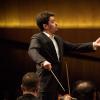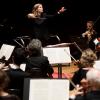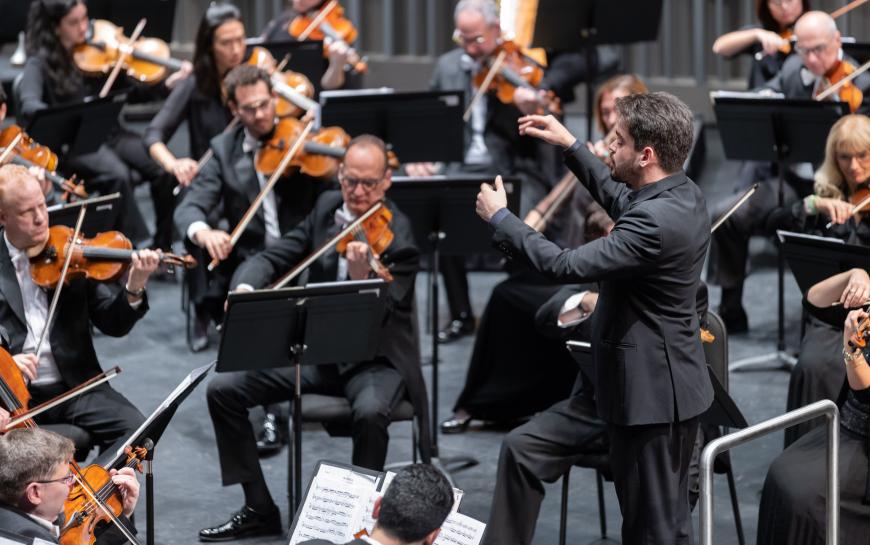
For 50 years, Zubin Mehta essentially was the face of the Israel Philharmonic — first as music advisor in 1969, then as its first music director in 1977, and finally, after a brave attempt to play music from Tristan und Isolde in a Wagner-phobic country, music director for life in 1981. Eventually, inevitably, the torch had to be passed, and in 2020, a young Israeli, Lahav Shani, was due to take the reins.
It was, to say the least, an inconvenient time to start a new post. The pandemic was on. A scheduled U.S. tour in November 2020 was canceled, and Shani didn’t really get started in his new job until this past April. But time passed, restrictions were lifted — and on Saturday night Nov. 5, Shani and the Israel Phil came to Los Angeles, landing at a space new to them, The Soraya in Northridge. (The orchestra would tour to Davies Symphony Hall with the same program the next night.)
What has changed in the interim with these ambassadors from an endlessly embattled Middle Eastern democracy? Less than one might suspect.
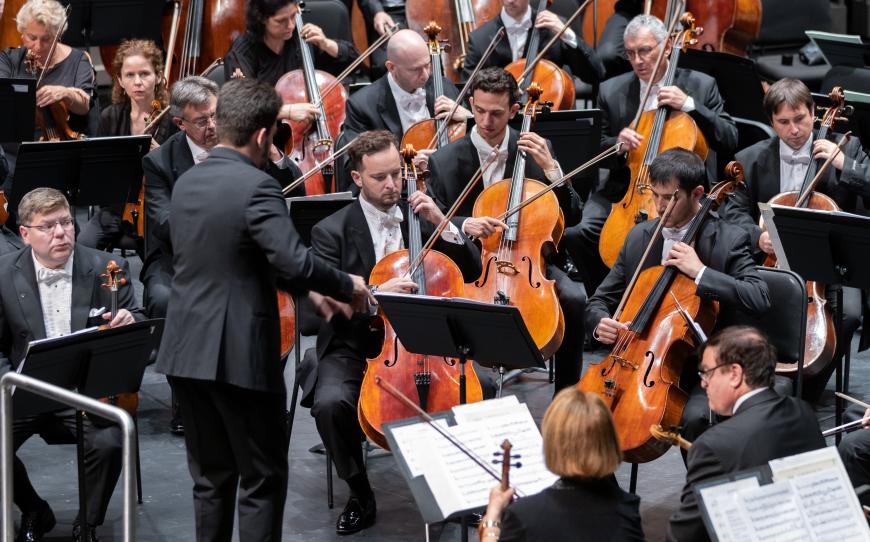
First of all, let it be said that the Israel Phil can be a chameleonic ensemble. I’ve heard the group play back-to-back concerts in the same hall in which the musicians produced almost entirely different timbres and textures with different conductors — Mehta on one night, Lorin Maazel the next. Nevertheless, the dark, heavyset Mehta sound seems to have stayed on as the default mode under Shani, at least on this given evening. As heard from a seat in the parterre section of The Soraya, the Israel Phil gave the Mehta sound an even darker set of colors, with ample hall reverberation smoothing out the strings. Yet details were smudged, and balances were sometimes off, with the timpani occasionally blotting everyone else out. It’s hard to say whether the lack of risers for everyone except the basses and low brass had much to do with the balance problems.
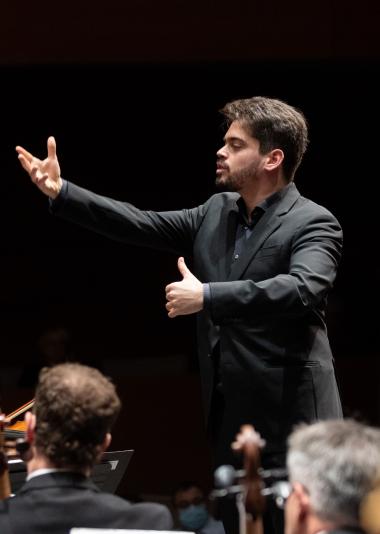
Although this was Shani’s first U.S. tour with the Israel Phil, he made his actual U.S. debut with the LA Phil at the Hollywood Bowl in 2015 at age 26, not long after he won the same Gustav Mahler Conducting Competition that launched Gustavo Dudamel a decade before. He didn’t make much of a musical impression at that concert, understandably handicapped by a hot summer night, short rehearsal time, and Antonín Dvořák’s overplayed “New World” Symphony as the main course. But physically, yes, he did come off as a young dynamo, all motion and sway, always conducting from memory.
Here at The Soraya, Shani, now 33, had a more imaginative, certainly better-prepared program to work with — two first symphonies by two Jewish composers from different centuries, Paul Ben-Haim and Gustav Mahler. It was reportedly the first time that any Mahler symphony had been heard in The Soraya, which is surprising because the hall has been around since 2011.
Ben-Haim (ne Frankenburger) was an emigre from Germany to Palestine before there even was an Israel Philharmonic, and he wrote this work for the orchestra in 1940 when it was known as the Palestine Symphony. It’s definitely a wartime piece, with an opening movement that teems with energy at the start, mystery in the middle, and a mighty march to close. The central slow movement has the expected lyrical flow, rising to a passionate climax and down again, while the feverish energy returns in the ultimately triumphant finale. The work is tonal, emphatically a product of the 20th century, yet it seems to belong to no specific school or region — not Central Europe, nor even the Middle East, except toward the close of the slow movement. It forms its own highly original ecosystem, cut off from Europe, trying to start a new life in the desert.
You can hear Shani and the Israel Phil go at Ben-Haim’s Symphony No. 1 in their first recording together, released in digital form only by Deutsche Grammophon on Oct. 28. (Interestingly, one of Mehta’s first recordings with the Israel Phil, also made when he was 33, was of two Jewish-flavored works by Ernest Bloch.) But they maybe recorded it too soon because the live performance Saturday had more punch and pungency, with sharper accents and more exquisitely molded lyrical passages. They really sold the piece, and they got a terrific ovation in response.
The Israel Phil’s Mahler tradition got started very early in its history and well before most orchestras caught on. There are mono recordings of the Symphonies Nos. 1 and 9 made in 1954 under the direction of the much-underrated Paul Kletzki – the Ninth is an especially fervent one; the musicians sound like they are playing for their very lives. Mehta continued and nurtured the tradition, and Leonard Bernstein brought his own passion to it.
What Shani brought to Mahler’s Symphony No. 1 is a young man’s approach to a young man’s symphony, with impulsive accelerations here and there, a very slow tempo to the passage after the first movement repeat, and a fourth movement storm with whiplash whomps from the drums. He was also capable of controlled tenderness in the passage of the finale that refers to the deleted “Blumine” movement. He gets the simultaneously sad, jaunty, satirical feeling of the Jewish music in the third movement, though he tried a bit too hard at times to give a cultured lilt to the Trio of the second movement. There were a few episodes of messy execution by the strings, and toward the end, the brass seemed to be tiring.
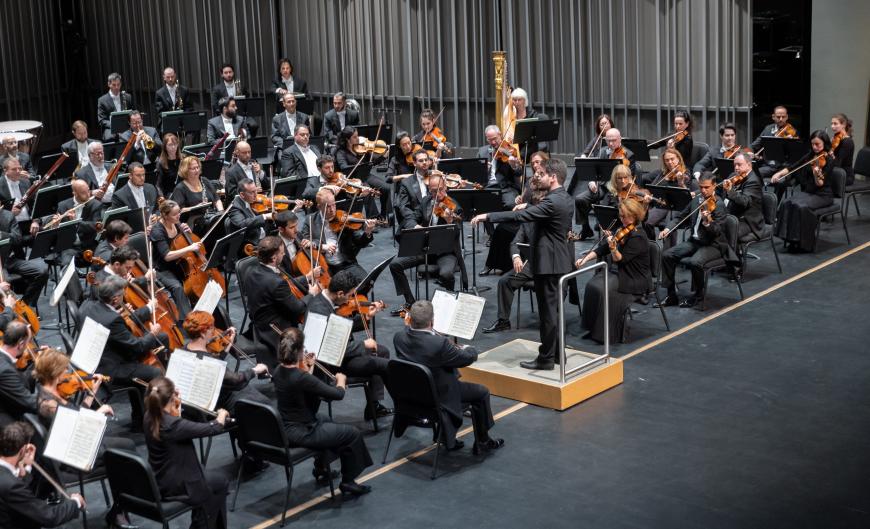
Shani works without a baton as well as without a score — he pleads, he cajoles, he exults with both arms. In one instance, through the “Frère Jacques” opening of the third movement, he made hardly any motions at all, just letting the players go through their rounds. He also likes to talk, offering an extended late greeting and verbal program note to the audience before leading a single encore, Ben-Haim’s Fanfare to Israel, which blared out its presence to start and turned lyrical with Jewish sadness before pouring on the pomp to close.
But the most affecting performance of all was that of the Israeli national anthem, “Hatikvah,” following the U.S. one. Just as in previous visits.


